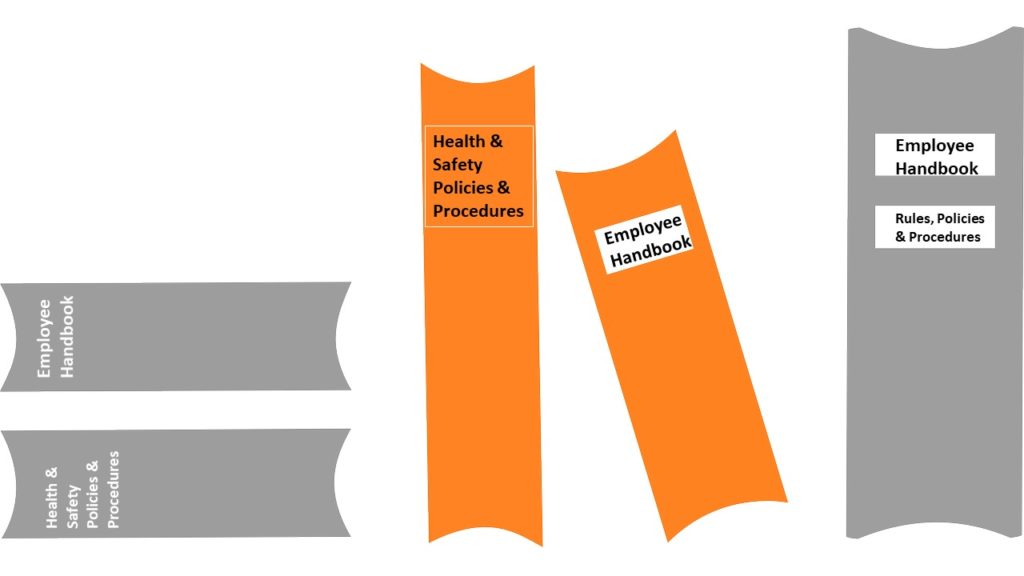What Happened?
If you have been around a while, you may remember when an employee handbook wasn’t much more than a pamphlet. Today that handbook starts to make War and Peace look like a paperback romance novel in comparison. Local, state, and federal laws, in addition to edicts from the numerous regulatory agencies have added to the complexity of today’s employee handbook or its equivalent. Find below the five questions you need to ask when reviewing your company’s employee handbook as well as your health and safety policies.
COVID Rules and Reality
The COVID-19 Pandemic has imposed new requirements for all employers. Some of those mandates had sunsets, others did not. Some are setting out there with question marks as to when they will, if ever, go away. And some of those requirements just didn’t make sense to any logical mind. Take for example the requirement to wear a mask while outside, especially working outside.

During a recent vacation trip to the Caribbean on the island of Grenada, I took time to observe safety practices at various construction sites. Scaffolding was assembled from bamboo and tree limbs. Workers were tied off to these rickety setups using a rope. One scene involved a co-worker holding onto the waistband of another worker as he leaned out with a grinder to cut rebar. Exposed electrical hazards abound at each site and no PPE to speak of, but they all wore face masks due to Grenada’s COIVD-19 requirements. Everywhere you looked you saw individuals working outside by themselves wearing surgical face masks.
Do They All Make Sense? Ask These Questions
There is not the perfect employee handbook or health and safety policy manual, but you can create one that best meets the needs of your organization.
- Do we have all the legal requirements addressed in understandable language?
Too many handbooks copy and paste the legalese from federal, state, and local documents. You may have met your legal requirement but do your employees understand it? Take the time to create documents that can be clearly understood.
- Which policies, rules, or procedures have been carried over with each publication that no longer applies?
Many organizations burden their handbooks and policy manuals with legacy documents that no longer are applicable. This is also true of collective bargaining agreements. Names and job titles change. Technology changes. Locations change. Establish routine reviews to address documents that no longer have meaning, significance, or importance to your organization or workforce.
- Was that policy, rule, or procedure written for a unique and specific incident?
How many pages of your handbook or policy manual are dedicated to a specific event or incident? Not everything that happens requires a new policy, rule, or procedure. Address the unique event or incident, learn from it, and move on. Too many become accustomed to creating a new rule, policy, or procedure as well as a new training program for everything that happens. This is the lazy leader approach to addressing challenges.
- Do they really make sense?
If you think you don’t have any policies, rules, or procedures that seem ridiculous, you obviously have not engaged your employees in the review process. Wearing a face mask working outside to protect against a virus while surrounded by dangers that are far more real may seem extreme, most likely you have a few policies, rules, or procedures that seem just as silly to your employees.
- Do my employees have access to the latest?
There was a time when keeping track of who had which version of the employee handbook or policy manual was a real challenge. Binders and printed copies lay on shelves all over the place. Today our digital world allows for stricter version and document control as well as tracking employee receipt and acknowledgment statements. If you haven’t made the move to digital versions, it is time.

Rules, policies, and procedures don’t have to be those scary things we want to avoid on our journey to success. A commitment to review regularly, involve your employees, and only keep what is necessary, will make these documents have greater significance in the employment experience of your workforce.
If this article helped you in any way, please share it with others. Until next time, look for solutions to your challenges among those who get the work done.

